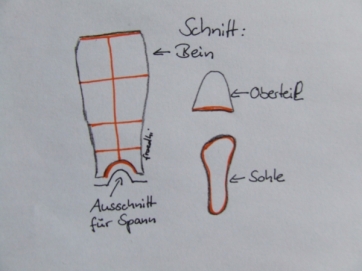Dies ist ein überarbeiteter Artikel aus meinem alten Blog – This is an edited article from my old blog
Im Spätmittelalter wurden Strümpfe meist aus Tuch genäht. In meinem Fall habe ich mich für feines Wolltuch in Köperbindung entschieden, welches ich mit dem 3. Zug Birke und Eisensulfat in ein helles Grün gefärbt habe.
In the late medieval period, stockings were often sewn from cloth. In this case I decided to take fine woolen cloth, which I dyed in the third bath of birchleaves with ferrous sulphate to get a light green.
Aber erstmal ging es ans Maßnehmen, und zwar nach folgendem Schema:
But first I took the measurements:

Measuring the circumference:
-below the knee
-widest point of calf
-where calf gets smaller
-thinnest point abve ankle
-over the instep
-around the sole
and the lenght
Danach habe ich ein Schnittmuster nach folgender Schemazeichnung auf ein Stück Probestoff übertragen, es an meinem Bein gesteckt und geschaut ob alles passt. An manchen Stellen habe ich gemerkt, das ich noch etwas enger stecken kann und hab das dann korrigiert.
Dabei muß man bedenken, daß man an der engsten Stelle über dem Knöchel noch etwas zugibt, damit man dann auch mit der Ferse durchkommt, auch wenn der Stoff sich etwas dehnt, bei mir mußte ich noch etwas in der Breite draufrechnen..
Then I made a pattern (see schematic drawing below) on a piece of cheap cotton to try it out and pinned it round my leg to see if it was fitting. In some places I had to pin it smaller and corrected it.
You have to remember, that you will need to add a bit on the thinnest point above the ankle, to slip your heel through it – even if the cloth is a bit flexible. I had to add some width at this point.

Schematic Pattern:
left – leg with cut out for the instep
right – upper part for the foot and sole
Wichtig ist, das man den Schnitt für Bein und Oberteil diagonal zum Fadenlauf zuschneidet. Der Stoff dehnt sich in der Diagonale und ihr bekommt so eine Art “Stretch-Effekt”. Die Sohle kann mit dem Fadenlauf zugeschnitten werden. Auf dem Bild unten seht ihr den Probeschnitt auf den Wollstoff gesteckt.
It’s necessary to cut the pattern for the leg and the upper part for the foot diagonally to the weave, so the fabric stretches a little more. The sole can be cut in the run of thread. On the picture below you can see the test pattern pinned to the wool.

Vor dem Nähen habe ich nochmal das Bein etwas nachgesteckt, da der Wollstoff sich noch etwas anders gedehnt hat als der Probestoff vorher.
Unten auf dem Bild links das Bein mit angestecktem Oberteil, rechts bei der Anprobe, nochmal nachgesteckt, damit der Stoff auch schön eng am Fuß sitzt. (Nicht über die breite Nahtzugabe wundern, die hatte ich mal sicherheithalber drangelassen, aber vor dem endgültigen versäubern dann noch gekürzt.)
Before I started sewing, I pinned the woolen cut again around my leg and made some small corrections, because it streched a bit different in comparison to the cotton test piece. On the left picture below: the leg with the upper part pinned to it. Right picture: the fitting, pinned closely to get the fabric nice and tight to the foot. (Don’t wonder about the wide seam allowance, I shortend it before I trimmed it)


Und hier das Resultat, zwei wunderbare Strümpfe, die schön kuschlig sind und eng am Fuß sitzen. Gehalten werden sie von zwei ledernen Strumpfbändern mit kleinen Schnallen.
And here the result – a wonderful pair of hosen, soft and cozy and tight – hold up by leather garters with small bronze buckles.






